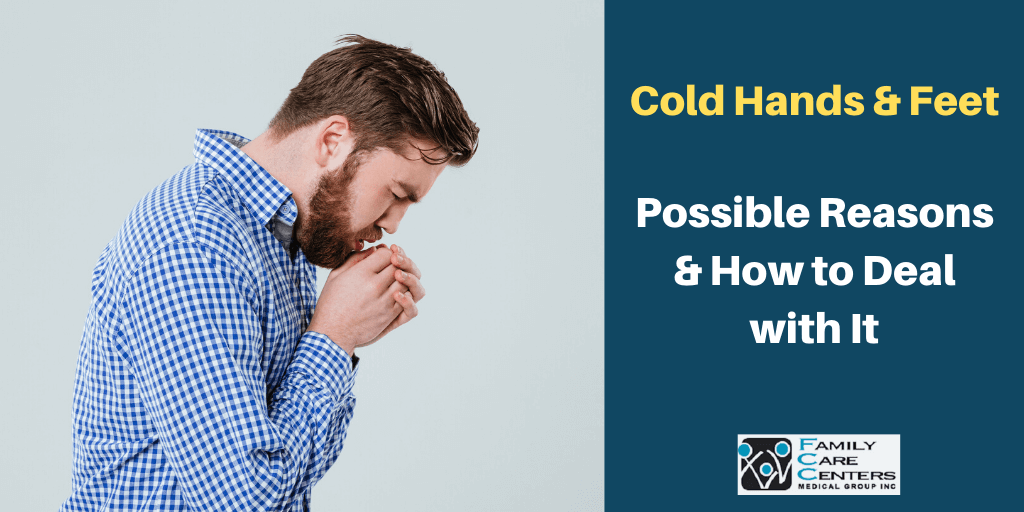

Fountain Valley Urgent Care Permanently Closed. We’re Here to Care for You at Our Other Locations.

Experiencing cold hands and feet is common in the winter but some people feel cold throughout the year due to a change in the body’s natural response to the environment. Your body changes how it manages the temperature of your feet and hands if you have anemia, vitamin B-12 deficiency, stress, an underactive thyroid, etc. Read on to learn more about the reasons for frosty hands and feet and how to deal with it.
When you are stressed, your body redirects blood away from your extremities towards your central core. This decreases the blood flow to your hands and feet, making them cold.
Solution: You can do meditation, relaxation exercises, or have a cup of tea to get rid of stress.
When it is cold outside, the blood vessels in your hands and feet will constrict and reduce the blood circulation to these areas. Exposure to cold temperatures may further cause:
Solution: Follow these tips to stay protected during cold temperatures:
• Limit your exposure to cold, windy, or wet weather.
• Make sure to cover your head, ears, neck, hands, and feet properly.
• Wear warm garments.
• Don’t drink alcohol if you plan to go out during the cold weather.
• Stay hydrated and eat a well-balanced meal.
Visit an Orange County urgent care center near you if you suspect you have severe frostbite or immersion injury.
Sitting for long periods reduces the blood flow and circulation that’s normally helped by movement. Sitting at a desk all day specifically decreases the blood flow to the feet and hands.
Solution: If you cannot take frequent breaks, at least make sure to change your posture. Stretching or moving your feet and legs can help.
Anemia occurs when you don’t have enough red blood cells to transport oxygen from your lungs to the rest of your body. This can result in cold feet and hands, as well as looking paler than usual.
Solution: There are different causes of anemia, including internal bleeding and, rarely, having problems processing iron or certain vitamins. See a doctor to identify whether you are anemic, and to determine which type.
The nicotine in tobacco products can make your blood vessels constrict, reducing blood flow to your extremities, contributing to cold hands and feet.
Solution: Nicotine or tobacco products in any form affect blood circulation. Avoid using them.
People with low metabolic rates can have cold hands and feet. Having a slow metabolism, can occur when you have low thyroid function or use drugs such as beta-blockers that cause poor blood circulation in the small vessels.
Solution: Follow these tips to increase your metabolism:
• Include protein in your diet, and eat spicy foods.
• Look into working out, especially a strength training regimen that stimulates active muscle growth.
The deficiency of vitamin B-12 can cause neurological symptoms such as tingling, numbness, or the feeling of cold hands and feet.
Solution: See a physician and discuss having your B-12 levels, checked, and discuss augmenting your diet, or possibly taking vitamin supplements.
Experiencing cold hands and feet is one of the symptoms of an underactive thyroid. In the case of an underactive thyroid, your thyroid does not produce adequate thyroid hormones to keep your body’s metabolic functions smooth and may increase your sensitivity to cold.
Solution: Under your doctor’s supervision, you can take thyroid supplements to correct an underactive gland.
Raynaud’s syndrome can randomly cause some parts of your body, such as fingers and hands, to feel numb, cold, and to change color. It causes the narrowing of arteries in your feet and hands, preventing normal blood flow. When the blood flow becomes normal, your fingers may swell, throb, or tingle.
Solution: Raynaud’s syndrome does not require treatment. However, if you feel discomfort because of cold hands, you can visit your doctor. They can prescribe medications to improve blood flow.
Lupus is a chronic autoimmune disease. It occurs when your body’s immune system mistakenly attacks your organs and tissues, and cold/pale hands and feet can be a symptom of it.
Solution: You can visit your doctor and get tested for lupus.
Experiencing cold feet and hands is common. However, you should consider visiting your doctor if:
Your cold hands and feet may be because of any of these underlying conditions. By identifying those reasons with proper medical attention, and following the treatment options, you can easily get rid of having frosty hands and feet, especially during the warmer seasons.
Share Your Valuable Thought